Are you looking for a natural oasis in the heart of Green Bay, Wisconsin? The Bay Beach Wildlife Sanctuary in Green Bay, WI offers an extraordinary escape into nature with its diverse wildlife, scenic trails, and educational opportunities. As the largest park in Green Bay and one of Wisconsin’s most treasured wildlife rehabilitation facilities, this 600-acre urban wildlife refuge combines conservation efforts with family-friendly recreation in a uniquely accessible setting.
Whether you’re a longtime local or planning your first visit, this comprehensive guide will help you discover everything the bay beach wildlife sanctuary green bay wi has to offer in 2025 – from its fascinating inhabitants to its seasonal events and hidden gems that make it a must-visit destination in northeastern Wisconsin.
Table of Contents

Quick Facts: Bay Beach Wildlife Sanctuary At-a-Glance
| Information | Details |
|---|---|
| Address | 1660 East Shore Drive, Green Bay, WI 54302 |
| Hours | Daily: 8:00 AM – 7:30 PM (May-August)<br>Daily: 8:00 AM – 4:30 PM (September-April)<br>[Check official website for holiday hours] |
| Admission | FREE (donations appreciated) |
| Phone | (920) 391-3671 |
| Website | Bay Beach Wildlife Sanctuary Official Site |
| Best For | Families, bird watchers, nature photographers, hiking enthusiasts, wildlife lovers |
| Accessibility | ADA-accessible main building, paved paths, and observation areas |
History & Mission: A Legacy of Conservation
The Bay Beach Wildlife Sanctuary in Green Bay, WI began its journey in 1936 as a small park with two deer pens. What started as a modest 250-acre plot has grown into the impressive 600-acre urban wildlife refuge we enjoy today. The sanctuary was established during the Great Depression when the city recognized the need for both wildlife conservation and public recreation space.
Originally serving as a waterfowl and deer sanctuary, the facility evolved to become one of Wisconsin’s leading wildlife rehabilitation centers. Since the 1970s, the bay beach wildlife sanctuary green bay wi has treated and rehabilitated thousands of orphaned and injured animals with the goal of returning them to their natural habitats whenever possible.
Today, the sanctuary’s mission extends beyond wildlife rehabilitation to include:
- Environmental education for all ages
- Protection of native Wisconsin wildlife
- Preservation of natural habitats
- Creating accessible nature experiences for the community
The sanctuary operates under a philosophy that combines conservation with education, believing that when people connect with wildlife in meaningful ways, they become better stewards of the natural world. This vision has made the Bay Beach Wildlife Sanctuary a beloved fixture in Green Bay and a model for urban wildlife refuges nationwide.
Getting There & Parking
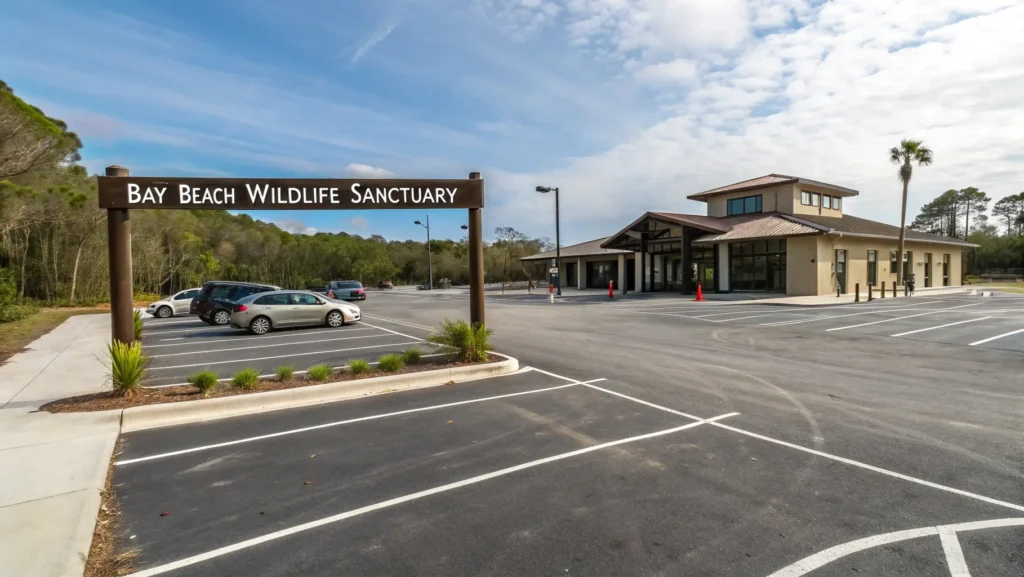
Directions to Bay Beach Wildlife Sanctuary
From Interstate 43 (North/South):
- Take I-43 to Webster Avenue/East Shore Drive exit
- Head north on East Shore Drive
- Continue approximately 1 mile
- The sanctuary entrance will be on your right
From Highway 41/141 (West):
- Take Highway 172 East to Webster Avenue
- Turn left (north) onto Webster Avenue
- Continue as Webster becomes East Shore Drive
- The sanctuary will be on your right after about 2 miles
From Downtown Green Bay:
- Take Main Street east to Monroe Avenue
- Turn right on Monroe Avenue
- Continue as Monroe becomes East Shore Drive
- The sanctuary will be on your left, approximately 10 minutes from downtown
Public Transportation
The Green Bay Metro Transit System serves the sanctuary via Route 4. The bus stops near the main entrance, making the sanctuary accessible for those without personal vehicles.
Parking Information
- Main Lot: Large, free parking area near the Nature Center
- Overflow Lot: Additional parking available during peak seasons and events
- Bus/RV Parking: Designated spaces for larger vehicles
- Accessibility: Multiple designated handicap spaces near the main entrance
All parking at the bay beach wildlife sanctuary green bay wi is free of charge. During summer weekends and special events, the main lot can fill quickly, so arriving early is recommended.
What to See & Do: Main Attractions
Wildlife Viewing Opportunities
The Bay Beach Wildlife Sanctuary in Green Bay, WI is home to over 4,500 animals annually, representing more than 200 Wisconsin native species. Many are permanent residents that cannot be released due to injuries or having been imprinted by humans. Here’s what you can expect to see:
Mammals
- White-tailed Deer: The sanctuary’s deer herd roams in a spacious enclosure where visitors can observe them up close. The best viewing times are early morning or late afternoon.
- Wolves: The timber wolf exhibit provides a rare opportunity to see these elusive predators. The sanctuary’s wolves were rescued as pups and cannot be released into the wild.
- Foxes: Both red and gray fox exhibits showcase these clever canids in naturalistic habitats.
- Otters: Don’t miss the playful river otters swimming and sliding in their pond habitat – a favorite for children and photographers alike!
Birds of Prey
- Bald Eagles: Several rehabilitated eagles that cannot be released call the sanctuary home.
- Owls: Great horned, barred, and screech owls can be seen in specialized enclosures.
- Hawks and Falcons: Various species including red-tailed hawks and American kestrels.
Waterfowl
- Native Ducks: Mallards, wood ducks, and many other species can be found on the sanctuary’s ponds.
- Geese: Canada geese and snow geese are common sights.
- Swans: Both trumpeter and mute swans glide gracefully across the sanctuary’s waters.
Wildlife Viewing Tips:
- Bring binoculars for better viewing of distant or shy animals
- Move slowly and speak quietly to avoid startling wildlife
- Visit during feeding times (posted at the Nature Center) for best viewing
- Check the rehabilitation status board to see what species are currently in care
Nature Center & Exhibits
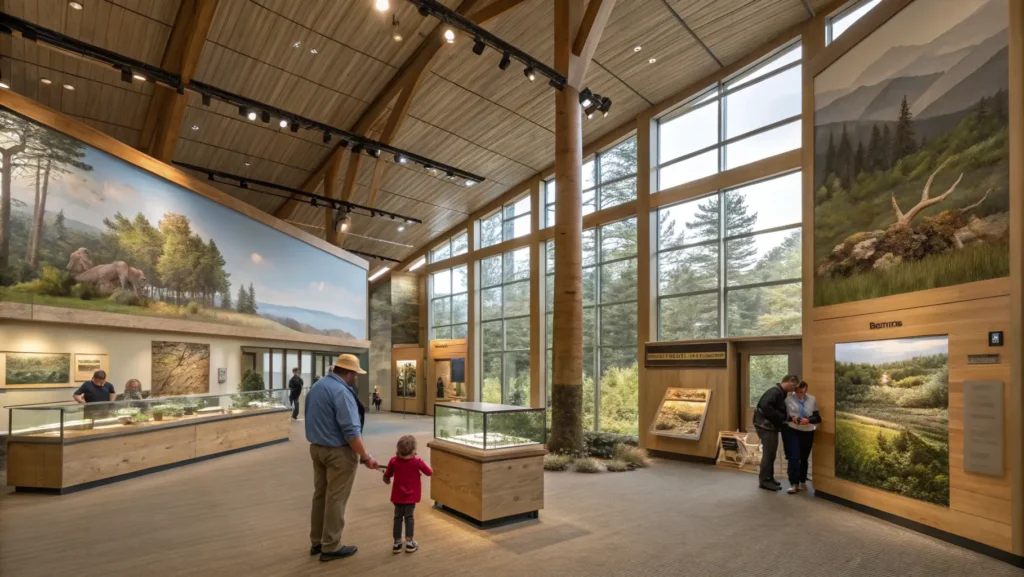
The R. Bud Baird Nature Center serves as the heart of the Bay Beach Wildlife Sanctuary. This modern facility offers visitors an introduction to Wisconsin’s natural ecosystems through interactive and educational exhibits.
Main Exhibits Include:
- Wisconsin Ecosystems Gallery: Life-sized dioramas of forest, prairie, and wetland habitats with taxidermy specimens in natural poses.
- Live Animal Room: Featuring smaller animals like turtles, snakes, and amphibians native to Wisconsin.
- Wildlife Rehabilitation Wing: A viewing window allows visitors to observe wildlife rehabilitation in action (feeding times posted daily).
- Children’s Discovery Corner: Hands-on activities, puzzles, and educational games for younger visitors.
- The Nature Connection: An interactive exhibit demonstrating how humans impact local ecosystems.
The Nature Center also houses a small gift shop where visitors can purchase wildlife-themed souvenirs, field guides, and educational toys. All proceeds benefit the sanctuary’s rehabilitation and educational programs.
Observation Tower
Rising 60 feet above the sanctuary grounds, the observation tower provides panoramic views of the Bay Beach Wildlife Sanctuary and beyond. On clear days, visitors can see across the bay to the shores of the Door Peninsula.
The tower features:
- Covered viewing platforms at multiple levels
- Educational signage identifying visible landmarks and common bird species
- Spotting scopes for wildlife viewing (free to use)
- Benches for resting and taking in the scenery
The tower is accessible via a series of staircases with landings at regular intervals. While not wheelchair accessible, many of the views can be enjoyed from ground-level observation decks throughout the sanctuary.
Hiking & Walking Trails

The Bay Beach Wildlife Sanctuary offers over 6 miles of trails that wind through diverse habitats including woodlands, wetlands, and prairies. Each trail has its own character and wildlife viewing opportunities:
Main Trail Network
| Trail Name | Distance | Difficulty | Highlights |
|---|---|---|---|
| Raptor Trail | 0.8 miles | Easy | Bird of prey exhibits, wooded areas |
| Woodland Trail | 1.2 miles | Moderate | Mature forest, seasonal wildflowers |
| Wetland Loop | 1.5 miles | Easy | Boardwalks, waterfowl viewing |
| Prairie Path | 0.7 miles | Easy | Native grasses, butterfly garden |
| Fox Trail | 1.0 mile | Moderate | Fox exhibits, varied terrain |
| Lake Loop | 1.3 miles | Easy | Lakeside views, beaver habitat |
Trail Accessibility
- Paved Trails: The Wildlife Viewing Trail and portions of the Wetland Loop are paved and wheelchair accessible.
- Boardwalks: Several elevated boardwalks provide stable surfaces through wetland areas.
- Natural Surface: Woodland trails have packed dirt or wood chip surfaces that may be difficult for wheelchairs or strollers.
Trail Safety & Etiquette
- Stay on marked paths to protect sensitive habitats
- Keep dogs and other pets at home (service animals only)
- Carry out all trash
- Do not feed wildlife
- Observe wildlife from a respectful distance
Specific Sanctuary Areas
Wolf Haven
A specially designed 2-acre enclosure houses the sanctuary’s wolf pack. The naturalistic habitat includes varying terrain, shelters, and enrichment features that allow the wolves to express natural behaviors. A viewing platform lets visitors observe these magnificent predators safely.
Waterfowl Management Area
This complex of ponds and wetlands provides critical habitat for resident and migratory waterfowl. Viewing blinds positioned strategically around the ponds allow for up-close observation without disturbing the birds. During migration seasons, hundreds of ducks, geese, and shorebirds can be seen resting and feeding here.
Deer Compound
Home to the sanctuary’s white-tailed deer herd, this spacious enclosure mimics the deer’s natural woodland habitat. Multiple viewing areas allow visitors to observe these graceful animals throughout the day. Educational signage explains deer behavior, biology, and conservation.
Birds of Prey Complex
This series of connected exhibits houses the sanctuary’s permanent raptor residents. Specially designed enclosures provide appropriate space and enrichment for eagles, hawks, owls, and falcons that cannot be released due to permanent injuries. Interpretive panels share each bird’s personal story and recovery journey.
Seasonal Guide to Bay Beach Wildlife Sanctuary

The Bay Beach Wildlife Sanctuary in Green Bay, WI transforms with the seasons, offering unique experiences throughout the year. Here’s what to expect during each season:
Spring (March-May)
Spring brings renewal to the sanctuary as wildlife becomes more active after the winter months.
Highlights:
- Baby animals begin appearing (fawns, ducklings, goslings)
- Spring migration brings diverse bird species through the area
- Woodland wildflowers bloom along forest trails
- Amphibians become active with spring rains
- Rehabilitation center becomes busy with orphaned wildlife
Recommended Activities:
- Dawn bird watching trips
- Wildflower photography
- Frog and toad surveys (volunteer opportunity)
- Earth Day celebrations (April)
Summer (June-August)
Summer is peak season at the bay beach wildlife sanctuary green bay wi with longer hours and special programming.
Highlights:
- Maximum wildlife activity and visibility
- Lush, green landscapes throughout the sanctuary
- Educational programs and camps for children
- Evening programs and extended hours
- Wildlife babies growing and developing
Recommended Activities:
- Early morning wildlife walks
- Canoe/kayak rentals on Manger Lagoon (weekends only)
- Summer day camps for children
- Wednesday evening concert series (July-August)
- Wildlife rehabilitation tours (scheduled dates)
Fall (September-November)
Autumn brings spectacular color to the sanctuary and marks a transitional period for wildlife.
Highlights:
- Brilliant fall foliage, especially in mid-October
- Fall bird migration
- Deer rutting season
- Less crowded trails and exhibits
- Special harvest and Halloween events
Recommended Activities:
- Fall color photography
- Migration watching from the observation tower
- Halloween Spooktacular event (late October)
- Apple cider weekends (Saturdays in October)
- Fall bird counts (volunteer opportunity)
Winter (December-February)
Winter transforms the sanctuary into a quiet wonderland with unique wildlife viewing opportunities.
Highlights:
- Snow-covered landscapes
- Easier tracking of mammals
- Winter bird species at feeders
- Wolves and foxes more active in cooler weather
- Holiday light displays (December)
Recommended Activities:
- Snowshoe hikes (equipment rentals available)
- Winter bird feeding stations
- Winter ecology programs
- Holiday Lights event (weekends in December)
- Wolf howl nights (full moon events)
For Families & Kids
The Bay Beach Wildlife Sanctuary in Green Bay, WI excels at creating engaging experiences for visitors of all ages, with special attention paid to families with children.
Kids’ Nature Nook
Located near the Nature Center, this dedicated children’s area features:
- Nature-themed playground with climbing structures resembling local wildlife
- Children’s garden with plants selected to attract butterflies and hummingbirds
- Hands-on discovery stations for exploring natural materials
- Child-sized wildlife viewing blinds
- Picnic area designated for families
Educational Programs
The sanctuary offers numerous programs specifically designed for children:
Daily Programs:
- Animal feeding demonstrations
- Junior Naturalist activities (weekends)
- Story time in the Nature Nook (weekday mornings)
Seasonal Programs:
- Summer Nature Camps (ages 4-14)
- School Break Camps (during major school vacations)
- Preschool Discovery Hours (ages 3-5)
- Family Night Hikes (monthly)
Interactive Learning
Throughout the sanctuary, families will find opportunities for interactive learning:
- Wildlife scavenger hunt maps available at the visitor center
- Kid-friendly interpretive signs with lift-flaps and tactile elements
- “Track stations” where children can match animal footprints
- Wildlife bingo games (cards available at the Nature Center)
Tips for Families
- Strollers can navigate most paved paths, but not all trails
- The Nature Center has changing tables in all restrooms
- Picnic areas are available for family lunches
- Water fountains are available but bringing your own water bottles is recommended
- Plan 2-3 hours minimum for a family visit to avoid rushing
Bird Watching Hotspot
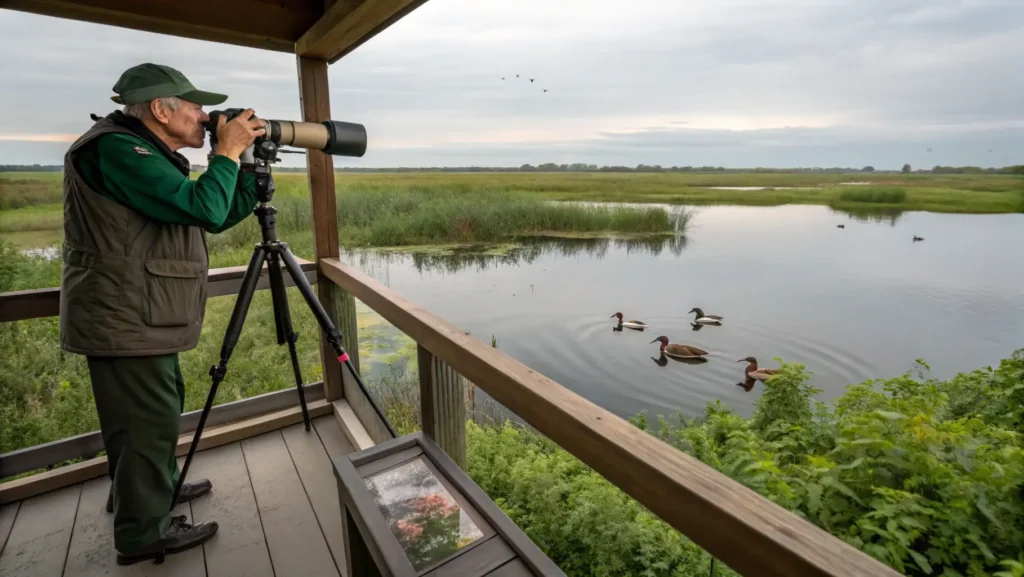
The bay beach wildlife sanctuary green bay wi has earned a reputation as one of northeastern Wisconsin’s premier bird watching destinations. With diverse habitats including wetlands, mature forests, and open meadows, the sanctuary attracts over 230 bird species throughout the year.
Notable Bird Species
- Year-round residents: Black-capped chickadee, northern cardinal, red-bellied woodpecker, white-breasted nuthatch
- Summer breeding species: Baltimore oriole, rose-breasted grosbeak, wood thrush, scarlet tanager
- Winter visitors: Snow bunting, pine siskin, common redpoll, northern shrike
- Migratory species: Various warblers, vireos, thrushes, waterfowl
Prime Birding Locations within the Sanctuary
- Observation Tower
- 360-degree views
- Excellent for spotting raptors and migrating flocks
- Height advantage for canopy species
- Wetland Boardwalks
- Water birds including herons, egrets, and rails
- Migratory waterfowl in spring and fall
- Marsh wrens and swamp sparrows in summer
- Manger Lagoon
- Waterfowl concentration area
- Shorebirds on mudflats during migration
- Waterbird viewing platforms
- Woodland Trails
- Interior forest species like wood thrush and ovenbird
- Woodpecker hotspot
- Spring migration waves of warblers (early May)
Seasonal Birding Calendar
| Season | Bird Watching Highlights |
|---|---|
| Spring | Peak warbler migration (May), waterfowl movement, courtship displays |
| Summer | Breeding birds with young, resident species most visible |
| Fall | Southbound migration waves, juvenile birds, waterfowl gathering |
| Winter | Feeder birds, northern finches, owls more visible |
Birding Tips for Bay Beach Wildlife Sanctuary
- Early morning (7-10 AM) provides the best birding opportunities
- Check the sightings board in the Nature Center for recent observations
- Join free guided bird walks (Saturday mornings, April-October)
- Download the sanctuary’s bird checklist from their website before visiting
- Consider bringing a spotting scope for waterfowl observation
Photography Tips
The Bay Beach Wildlife Sanctuary offers endless opportunities for nature photography throughout the seasons. Here are some insider tips for capturing memorable images:
Best Photography Locations
- Wolf Enclosure Viewing Area
- Morning light illuminates wolves in their natural behaviors
- Long lens (200mm+) recommended
- Best opportunities during feeding times (check schedule)
- Raptor Exhibits
- Close-up portraits of eagles, hawks, and owls
- Photograph through special camera ports to minimize fence interference
- Soft morning or late afternoon light works best
- Wetland Boardwalks
- Reflection opportunities in still water
- Sunrise/sunset over the wetlands
- Macro opportunities with aquatic plants and insects
- Observation Tower
- Panoramic vistas across the sanctuary
- Bird’s-eye view of changing seasons
- Dramatic weather and cloud formations
Seasonal Photo Opportunities
- Spring: Baby animals, woodland wildflowers, migrating birds
- Summer: Lush landscapes, butterflies, active wildlife
- Fall: Spectacular foliage, misty mornings, fungi
- Winter: Snow-covered landscapes, winter wildlife, frost patterns
Photography Tips Specific to the Sanctuary
- Visit on weekdays or early mornings to avoid crowds in your shots
- Consider a macro lens for capturing small wildlife and plants
- Bring a tripod for low-light conditions (especially forest trails)
- Use polarizing filters when photographing water scenes
- Practice ethical wildlife photography – never stress animals for a better shot
Photo Blind Reservations
The sanctuary offers two dedicated photography blinds that can be reserved in advance:
- Wetland Blind (ideal for waterfowl)
- Forest Edge Blind (excellent for songbirds and deer)
Contact the Nature Center at least 48 hours in advance to reserve these specialized photography locations.
Events & Programs

The Bay Beach Wildlife Sanctuary hosts a variety of events and educational programs throughout the year that enhance the visitor experience and support their conservation mission.
Recurring Events
Weekly Programs
- Wild Wednesday Presentations (Year-round): Weekly educational presentations featuring live animals
- Weekend Wildlife Walks (April-October): Guided naturalist hikes exploring seasonal highlights
- Feeding Tours (Daily): Behind-the-scenes tours of feeding routines for permanent animal residents
Monthly Events
- Full Moon Walks (Year-round): Evening guided walks exploring nocturnal wildlife
- Sanctuary Speakers Series (September-May): Guest lectures on wildlife and conservation topics
- Wildlife Photography Club (First Saturday): Gatherings for photographers of all skill levels
Seasonal Special Events
Spring
- Earth Day Celebration (April): Environmental activities, tree planting, and conservation exhibits
- Spring Migration Festival (May): Bird walks, identification workshops, and migration education
Summer
- Wildlife Baby Shower (June): Educational event about wildlife babies and rehabilitation efforts
- Summer Concert Series (Wednesdays in July/August): Evening music in the outdoor amphitheater
- Summer Nature Camps (June-August): Weekly day camps for children ages 4-14
Fall
- Fall Festival (September): Celebration of autumn with family activities and apple cider pressing
- Halloween Spooktacular (October): Non-scary celebration of nocturnal wildlife
Winter
- Winter Wildlife Workshop (January): Indoor educational programs about winter adaptations
- Holiday Light Display (December): Evening light display highlighting Wisconsin wildlife
Educational Programs
For Schools
- Field Trip Programs: Curriculum-based programs for K-12 students
- Outreach Programs: Naturalists bring wildlife education to classrooms
- Teacher Workshops: Professional development for educators
For Adults
- Master Naturalist Training: Wisconsin Master Naturalist certification courses
- Wildlife Rehabilitation Workshops: Introduction to wildlife rehabilitation practices
- Volunteer Training Programs: Various specialized training for sanctuary volunteers
Registration Information
- Most programs require advance registration
- Many programs offer member discounts
- School programs should be booked at least one month in advance
- Registration available online, by phone, or at the Nature Center
Facilities & Amenities
The Bay Beach Wildlife Sanctuary provides numerous facilities and amenities to ensure a comfortable and enjoyable visit for all guests.
Main Buildings
- R. Bud Baird Nature Center: Exhibits, information desk, gift shop, classrooms, and restrooms
- Observation Building: Indoor wildlife viewing areas and educational displays
- Wildlife Rehabilitation Center: Treatment facilities for injured and orphaned wildlife (limited public access)
Comfort Facilities
- Restrooms: Located in the Nature Center, Observation Building, and at trailheads
- Water Fountains: Available in main buildings and strategic locations throughout the grounds
- Rest Areas: Benches and seating areas positioned along trails and near exhibits
Picnic Areas
- Main Picnic Grove: Tables, grills, and shelter near the Nature Center
- Woodland Picnic Area: Secluded tables in a forested setting
- Lagoon Overlook: Limited picnic seating with water views
Accessibility Features
The Bay Beach Wildlife Sanctuary strives to be accessible to all visitors:
- Wheelchair-Accessible Trails: Paved paths connect major exhibits and viewing areas
- Accessible Restrooms: Available in all main buildings
- Reserved Parking: Designated accessible parking spaces near entrances
- Sensory Guides: Available at the information desk for visitors with sensory sensitivities
- Service Animals: Welcome throughout the sanctuary (please notify staff upon arrival)
- Accessible Picnic Tables: Modified tables available in main picnic areas
- Assistive Listening Devices: Available for scheduled tours and programs
Gift Shop
The Nature Center gift shop offers:
- Field guides and nature books
- Wildlife-themed gifts and souvenirs
- Local crafts and artwork
- Educational toys and games
- Bay Beach Wildlife Sanctuary branded merchandise
All proceeds from gift shop purchases directly support the sanctuary’s wildlife rehabilitation and educational programs.
Planning Your Visit
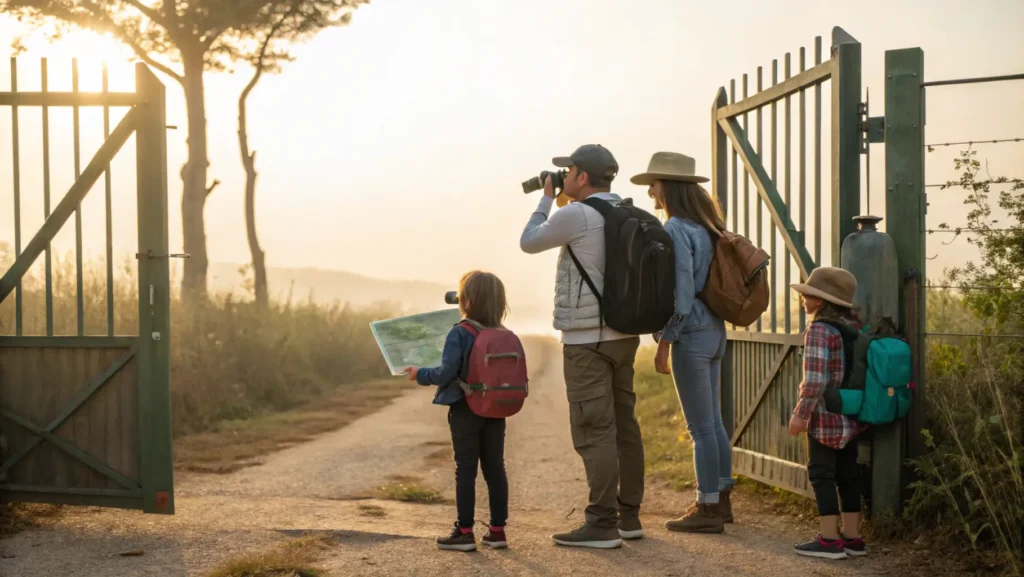
When to Visit
- Best Wildlife Viewing: Early morning (8-10 AM) or late afternoon (4-6 PM)
- Quietest Times: Weekday mornings, especially Tuesday through Thursday
- Busiest Times: Summer weekends, holidays, and during special events
- Ideal Visit Duration: 2-4 hours to fully experience the sanctuary
What to Bring
- Essentials: Water bottle, comfortable walking shoes, weather-appropriate clothing
- Recommended: Binoculars, camera, insect repellent (summer), sunscreen
- Optional: Field guides, sketchbook, small backpack for supplies
- Winter Visits: Warm layers, hat, gloves, and ice cleats for trails
Visitor Etiquette & Rules
- Stay on designated paths and trails
- No pets allowed (service animals excepted)
- Do not feed the wildlife
- Keep noise levels low to avoid disturbing animals
- Take only photographs, leave only footprints
- No smoking anywhere on sanctuary grounds
- Drones are prohibited without special permission
Weather Considerations
- Most exhibits are outdoors and subject to weather conditions
- The Nature Center provides indoor activities during inclement weather
- Some trails may close temporarily after heavy rain
- Winter ice and snow may limit accessibility to certain areas
Tips for a Great Visit
- Download the sanctuary map from their website before arriving
- Check the events calendar for special programs during your visit
- Consider becoming a member for free parking and program discounts
- Arrive early for the best wildlife viewing opportunities
- Visit on weekdays if possible to avoid crowds
Volunteer & Support Opportunities
The Bay Beach Wildlife Sanctuary relies on community support to fulfill its mission of wildlife rehabilitation, conservation, and education. Here are ways you can contribute:
Volunteer Programs
The sanctuary offers various volunteer opportunities for different interests and skill levels:
- Wildlife Rehabilitation Assistants: Help care for injured and orphaned wildlife
- Education Volunteers: Assist with public programs and school groups
- Trail Maintenance Team: Help maintain the sanctuary’s extensive trail system
- Special Events Support: Assist with fundraising and community events
- Visitor Services: Greet visitors and provide information at the Nature Center
Volunteer applications are accepted year-round, with training sessions offered quarterly. A minimum commitment of 4 hours per month is requested for most positions.
Membership
Becoming a member of the Bay Beach Wildlife Sanctuary provides valuable support while offering benefits:
Membership Levels:
- Individual: $30/year
- Family: $50/year
- Supporting: $100/year
- Patron: $250/year
- Lifetime: $1,000
Member Benefits:
- Free parking
- Discounts on programs and events
- Member-only previews of new exhibits
- Quarterly newsletter
- Reciprocal admission to participating nature centers nationwide
Donations
Financial contributions in any amount help support wildlife care and sanctuary operations:
- General Fund: Supports overall operations
- Wildlife Rehabilitation Fund: Specifically for animal care expenses
- Education Fund: Supports school programs and educational exhibits
- Memorial Gifts: Honor a loved one with a lasting tribute
Donations can be made online, by mail, or in person at the Nature Center.
Adopt-an-Animal Program
This popular program allows individuals or groups to symbolically “adopt” one of the sanctuary’s permanent resident animals:
- Adoption packages range from $25-$100
- Includes adoption certificate, animal photo, and information
- Makes an excellent gift for wildlife enthusiasts
Corporate Partnerships
Local businesses can support the sanctuary through:
- Event sponsorships
- Matching gift programs
- In-kind donations
- Team volunteer days
For more information on any support opportunity, contact the sanctuary’s development office at (920) 391-3685 or visit the support section of their website.
Nearby Attractions & Food

While the Bay Beach Wildlife Sanctuary deserves a full day of exploration, Green Bay offers many complementary attractions nearby. Here are some recommendations to enhance your visit:
Nearby Attractions
All of these destinations are within a 15-minute drive of the sanctuary:
Bay Beach Amusement Park
- Located directly adjacent to the wildlife sanctuary
- Historic amusement park with rides for all ages
- Famous Zippin Pippin wooden roller coaster
- Affordable ride tickets and free admission
- Perfect pairing with a sanctuary visit
NEW Zoo & Adventure Park
- Green Bay’s accredited zoo featuring animals from around the world
- Adventure Park with climbing walls and zipline courses
- Located approximately 10 minutes from the sanctuary
- Complementary wildlife experience
National Railroad Museum
- One of America’s oldest and largest railroad museums
- Historic locomotives and train cars
- Train rides available seasonally
- Located just 5 minutes from the sanctuary
University of Wisconsin-Green Bay Arboretum
- 290 acres of natural areas and trails
- Botanical gardens and native plant collections
- Free admission
- Located about 10 minutes from the sanctuary
Dining Options
Near the Sanctuary (within 5 minutes)
- The Depot Café – Train-themed family restaurant with sandwiches and comfort food
- Zesty’s Frozen Custard – Local favorite for custard and casual meals
- Sammy’s Pizza – Family-friendly pizza place with Italian classics
Picnic Options
- Festival Foods (10-minute drive) – Local grocery store with excellent deli for picnic supplies
- The Bottle Room (7-minute drive) – Specialty shop with cheeses, meats, and picnic essentials
Downtown Green Bay (15-minute drive)
- Titletown Brewing Company – Brewery restaurant in historic train depot
- Hagemeister Park – Casual American fare with outdoor seating
- Copper State Brewing – Craft brewery with elevated pub food
Accommodation
If you’re visiting from out of town, consider these lodging options:
- Hampton Inn Green Bay Downtown – Located near the Fox River, central to attractions
- Lodge Kohler – Upscale hotel in the Titletown District
- Comfort Suites Green Bay – Family-friendly option with indoor pool
- Astor House B&B – Historic bed and breakfast in the Astor neighborhood
Frequently Asked Questions
General Information
Q: How much does it cost to visit the Bay Beach Wildlife Sanctuary?
Admission to the Bay Beach Wildlife Sanctuary in Green Bay, WI is FREE. The sanctuary operates on donations, memberships, and program fees. Donation boxes are located throughout the facility.
Q: What are the sanctuary’s hours?
The sanctuary grounds are open daily from 8:00 AM to 7:30 PM (May-August) and 8:00 AM to 4:30 PM (September-April). The Nature Center hours are 8:00 AM to 4:30 PM year-round.
Q: Is the sanctuary open year-round?
Yes, the Bay Beach Wildlife Sanctuary is open 365 days a year, including holidays, though hours may be reduced on major holidays.
Q: How much time should I plan for my visit?
Most visitors spend 2-4 hours exploring the sanctuary. To see everything, including all trails and exhibits, plan for at least half a day.
Visiting with Kids & Groups
Q: Is the sanctuary suitable for young children?
Absolutely! The sanctuary offers many child-friendly exhibits, a nature-themed playground, and interactive elements designed specifically for younger visitors.
Q: Do you offer birthday parties or private events?
Yes, the sanctuary offers birthday party packages and facility rentals for private events. Advance reservation is required, typically 3-4 weeks ahead.
Q: Can we bring a school group or scout troop?
The sanctuary welcomes educational groups. School programs should be booked at least one month in advance by calling (920) 391-3671 or through the online reservation system.
Wildlife & Exhibits
Q: Will we definitely see wolves/eagles/deer during our visit?
The sanctuary has permanent resident wolves, eagles, and deer in dedicated exhibits that can be seen during regular visiting hours. Wild animals may be more active during morning and evening hours.
Q: Can we feed the animals?
No, visitors are not permitted to feed any animals at the sanctuary. Feeding wildlife can cause health problems and create dangerous dependencies.
Q: What happens to the rehabilitated animals?
The sanctuary’s goal is to return rehabilitated animals to the wild. Animals that cannot survive in the wild due to permanent injuries become permanent residents or are transferred to appropriate facilities.
Practical Matters
Q: Is the sanctuary wheelchair accessible?
Many areas of the sanctuary are accessible, including the Nature Center and paved main trails. Some natural surface trails may not be suitable for wheelchairs, especially after rain.
Q: Can we bring our dog to walk on the trails?
No, pets are not allowed at the Bay Beach Wildlife Sanctuary in order to protect the wildlife. Service animals are welcome.
Q: Is there food available at the sanctuary?
The sanctuary does not have a restaurant or café, but there are picnic areas where you can enjoy food brought from home. Several restaurants are located within a short drive.
Q: Is photography allowed?
Photography for personal use is encouraged! Commercial photography requires prior permission. Please respect wildlife by not using flash photography around the animals.
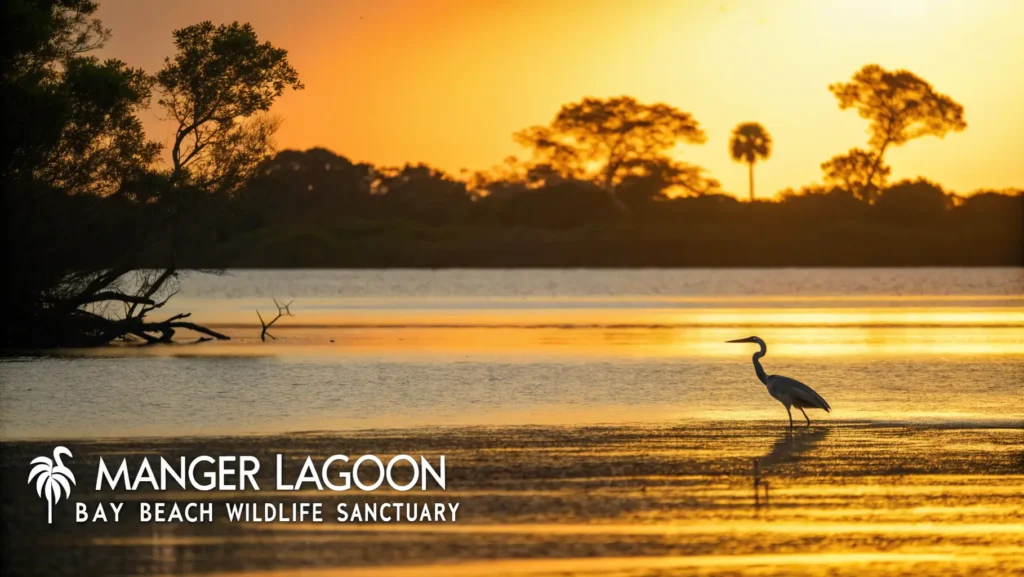
Conclusion: Experience the Natural Wonder of Bay Beach Wildlife Sanctuary
The Bay Beach Wildlife Sanctuary in Green Bay, WI stands as a testament to how urban areas can preserve and celebrate their natural heritage. With its commitment to wildlife rehabilitation, environmental education, and accessible nature experiences, the sanctuary offers something for everyone – from casual visitors to dedicated naturalists.
As you plan your visit to Green Bay, make sure to allocate ample time to explore this 600-acre urban wildlife refuge. Whether you’re watching the graceful flight of a rehabilitated eagle, observing the playful antics of river otters, or simply enjoying a peaceful walk through the changing seasons, the Bay Beach Wildlife Sanctuary provides a refreshing connection to the natural world.
By supporting the sanctuary through your visit, donations, or volunteer time, you become part of a community committed to protecting Wisconsin’s wildlife for future generations. We hope this guide enhances your experience and inspires you to discover all that this remarkable place has to offer.
Have you visited the Bay Beach Wildlife Sanctuary? Share your experiences, tips, and favorite memories in the comments below!
This guide is updated as of May 2025. While we strive to provide the most accurate information possible, hours, fees, and exhibit availability may change. Please check the official Bay Beach Wildlife Sanctuary website for the most current information before your visit.


